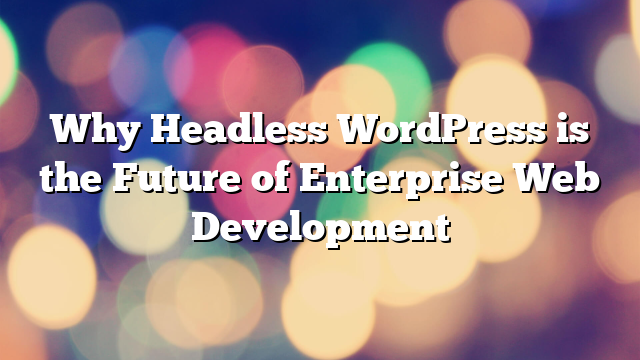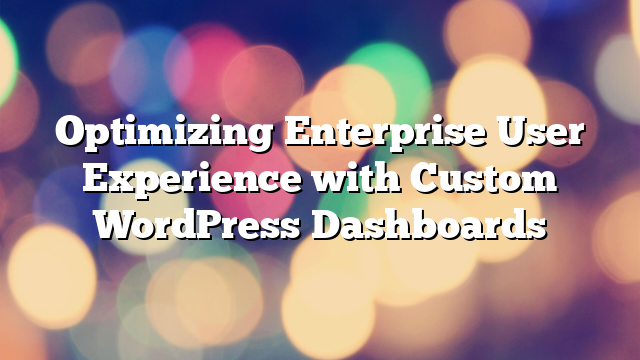Why Headless WordPress is the Future of Enterprise Web Development
16.09.2024

The digital landscape is rapidly evolving, and enterprises are constantly seeking innovative ways to deliver content across multiple platforms while maintaining high performance and flexibility. Headless WordPress has emerged as a leading solution for these needs, offering a modern approach to content management that decouples the backend from the frontend. At our enterprise web development services, we specialize in implementing headless WordPress solutions that empower enterprises to achieve their digital goals. This article explores why headless WordPress is becoming the future of enterprise web development.
What is Headless WordPress?
Headless WordPress is a content management system (CMS) architecture where the backend (WordPress) is decoupled from the frontend. This means that WordPress is used solely for content management, and the content is delivered via APIs to various frontends, such as websites, mobile apps, and even IoT devices. This decoupling offers several key advantages:
- Flexibility: Use different technologies for the frontend, allowing for custom development that meets specific business needs.
- Scalability: Easily scale both the backend and frontend independently to handle growing traffic and content.
- Omnichannel Delivery: Deliver content consistently across multiple platforms and devices, ensuring a seamless user experience.
- Improved Performance: Optimize the frontend for speed and performance, ensuring fast load times and better SEO.
Benefits of Headless WordPress for Enterprises
Enterprises can leverage headless WordPress to meet their complex content management needs while maintaining flexibility and control. Here are some key benefits:
- Custom Frontend Development: Use modern frontend technologies like React, Next.js, or Angular to create highly interactive and responsive user interfaces.
- Enhanced Security: By decoupling the frontend from the backend, the attack surface is reduced, leading to improved security.
- Future-Proofing: Easily integrate with emerging technologies and platforms, ensuring that your content delivery remains relevant in a rapidly changing digital landscape.
- Global Reach: Deliver localized content across different regions, catering to a global audience while maintaining centralized content management.
Implementing Headless WordPress with APIs
The key to headless WordPress is its ability to deliver content via APIs. Here’s how it works:
- REST API: WordPress’s REST API allows developers to fetch content from the WordPress backend and display it on various frontends, enabling dynamic content delivery.
- GraphQL API: For more flexibility, GraphQL can be used to query content, allowing developers to request only the data they need, reducing the amount of data transferred and improving performance.
- Custom API Endpoints: Develop custom API endpoints tailored to your enterprise needs, enabling more complex integrations and data retrieval.
Real-World Applications of Headless WordPress
Headless WordPress is versatile and can be applied to a wide range of enterprise scenarios. Here are some real-world applications:
- Enterprise Portals: Create dynamic enterprise portals that serve content to employees, partners, and customers across different devices and platforms.
- E-Commerce Solutions: Develop high-performance e-commerce platforms with custom frontends that provide a seamless shopping experience.
- Mobile Applications: Deliver content from WordPress to mobile apps, ensuring consistent and up-to-date information across all devices.
- Digital Signage: Use headless WordPress to manage and deliver content to digital signage systems, enabling real-time updates and centralized management.
Best Practices for Headless WordPress Implementation
Successfully implementing headless WordPress requires careful planning and execution. Here are some best practices to consider:
- Define Your Requirements: Clearly outline your goals and requirements for the headless setup, including the platforms you need to support and the content types you’ll be managing.
- Choose the Right Frontend Technology: Select a frontend technology that aligns with your business needs and offers the performance and flexibility required for your application.
- Optimize for Performance: Ensure that your APIs and frontend are optimized for speed and performance, including caching strategies and efficient data retrieval methods.
- Security Considerations: Implement strong security measures, such as secure API authentication, data encryption, and regular security audits.
- Continuous Testing and Monitoring: Regularly test and monitor your headless WordPress implementation to identify and resolve issues before they impact users.
Conclusion: Embracing the Future with Headless WordPress
Headless WordPress represents the future of enterprise web development, offering unparalleled flexibility, performance, and scalability. At our enterprise web development services, we are experts in implementing headless WordPress solutions that empower businesses to deliver content seamlessly across multiple platforms. Whether you’re looking to modernize your existing website or build a new digital experience, our team has the expertise to bring your vision to life. Contact us today to learn how headless WordPress can transform your enterprise web strategy.



